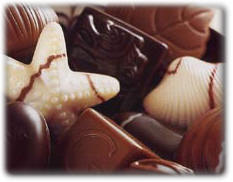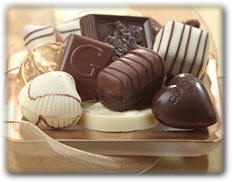 |
|

Godiva Chocolates I
Godiva Chocolates II
Godiva History
How Godiva is Made?
Godiva Box Contents
Home
Executive Bean Dispenser
MapleRidgeFarms Catalog
Mint Your Brand
Holiday Gift Sets
Creative Gourmet Ideas
Godiva Chocolates
Godiva Delicious
Nestle Custom Chocolates
Mapleridge Gourmet Food
Sugardale Pvt Collection
Almonds Nuts Peanuts
Cheese Lovers
Gourmet Bucket of Treats
Gourmet in Crystal Bowl
Gourmet Treasure Chest
Fine Gourmet Chocolates
|


We Accept Check or Charge Cards
 |
| |
| |
|
|
|
 |
Godiva History
Chocolate Lover's Time Line by
Godiva
|
 A Chocolate Lover's Timeline A Chocolate Lover's Timeline |
 600 - Using Your Bean 600 - Using Your Bean
Fourteen centuries before Godiva introduced luxury chocolates to the
American market, the cocoa bean is considered the ultimate status symbol
in the Mayan and Aztec cultures. They use the beans as currency and
those wealthy enough to have an excess of beans use them to make a
chocolate drink that gives them "wisdom and power."
|
|
 TOP OF PAGE
TOP OF PAGE

|
 How
Godiva Chocolate is made? How
Godiva Chocolate is made? |
 Godiva uses two production methods to manufacture the various sizes
and shapes of our chocolates: enrobing and shell-molding. Enrobing
involves coating a formed center, like rich caramel, with smooth,
melted chocolate. The shell-molding process is practiced extensively
in Europe, and it is the method used to manufacture most Godiva
chocolates. Godiva uses two production methods to manufacture the various sizes
and shapes of our chocolates: enrobing and shell-molding. Enrobing
involves coating a formed center, like rich caramel, with smooth,
melted chocolate. The shell-molding process is practiced extensively
in Europe, and it is the method used to manufacture most Godiva
chocolates.more
>> |
|
 TOP OF PAGE
TOP OF PAGE

|
 More Creative
Ideas More Creative
Ideas |
|
 GO TOP OF PAGE
GO TOP OF PAGE



|
Promotional Products by Brands
or Categories |
|
|
|
Make them
Remember
YOU and YOUR Business
     


Click to Search
By Category
By Price
By Word

Ask FREE
CyberSample


Want Small
quantity Fast
Just Click Here
to Order online
|
 |